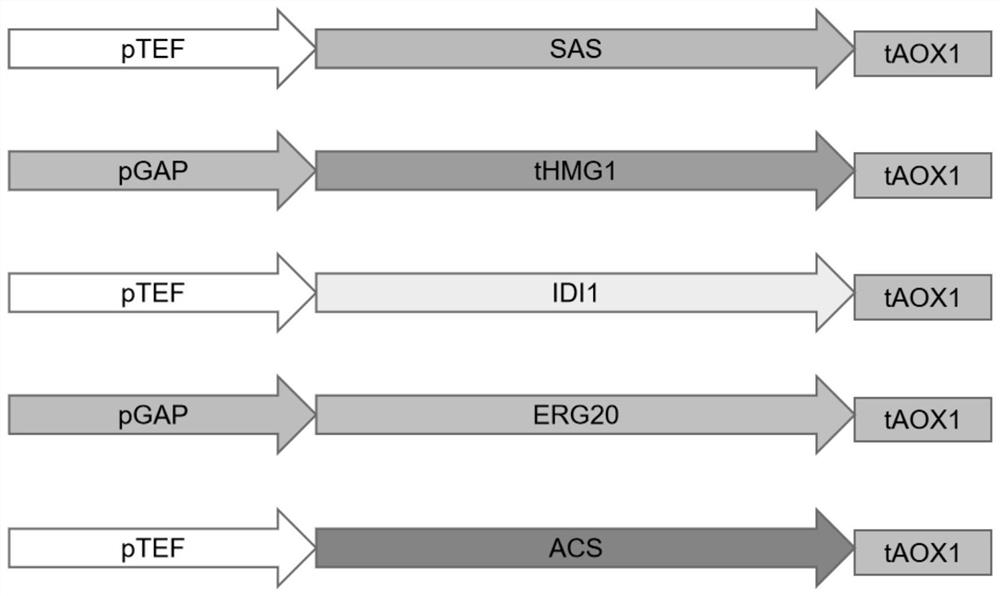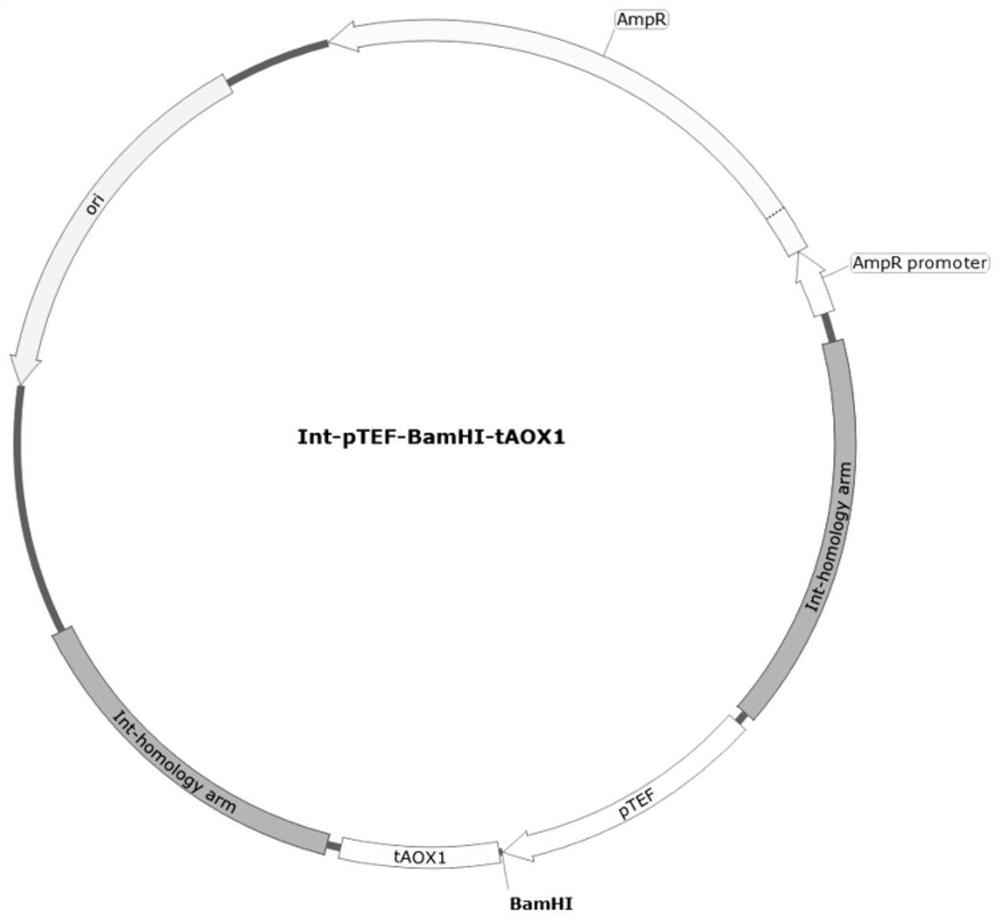Engineered yeast for fermentation production of alpha-santalene and application of engineered yeast
A technology of yeast engineering and santalene, which is applied in the field of bioengineering, can solve the problems of low yield and limited application, and achieve the effects of broad application prospects, resource saving, and short cycle
- Summary
- Abstract
- Description
- Claims
- Application Information
AI Technical Summary
Problems solved by technology
Method used
Image
Examples
Embodiment 1
[0043] Embodiment 1: Construction of Pichia santalene recombinant strain Pa-1
[0044] The Int refers to the insertion site of the Pichia pastoris GS115 genome, and the used auxiliary plasmid Int-pTEF-tAOX1, Int-pGAP-tAOX1 consists of a general framework (ampicillin resistance gene expression cassette plus prokaryotic gene plasmid origin of replication ori), 500bp homology arms upstream and downstream of the site, and pTEF-BamHI-tAOX1 or pGAP-AatⅡ-tAOX1 (see the plasmid map image 3 , Figure 4 ); the helper plasmids HZP-sgRNA, HHP-sgRNA and HGP-sgRNA consist of a general framework, resistance gene expression cassette, sgRNA corresponding to the site, and BsaI restriction site, Z, H, and G represent bleomycin resistance sex gene, hygromycin resistance gene and G418 resistance gene (see plasmid map Figure 5 , Figure 6 , Figure 7 ); P is a plasmid (plasmid).
[0045] Starting from the helper plasmid Int2-pTEF-tAOX1 (preserved in the laboratory, Int2 left gene PAS_chr1-3_00...
Embodiment 2
[0060] Embodiment 2: Construction of Pichia santalene recombinant strain Pa-2
[0061] The expression cassettes of highly expressed genes tHMG1, IDI1, and ERG20 and the corresponding guide plasmids were respectively constructed, and they were sequentially transferred into the above-mentioned recombinant strain Pa-1, and the Pichia pastoris recombinant strain Pa-1-1 was obtained after successive rounds of transformation. , Pa-1-2 and Pa-2, the specific implementation is as follows:
[0062] (1) Construction of tHMG1 recombinant expression vector
[0063] Using the Saccharomyces cerevisiae genome as a template, design primers tHMG1-F / tHMG1-R to amplify the target gene tHMG1 (as shown in SEQID NO.2), and use the seamless cloning method to combine it with the vector Int12-pGAP- tAOX1 (Int12: left gene PAS_chr3_1202, right gene PAS_chr3_0618) was assembled and transformed into Escherichia coli DH5α strain to obtain the recombinant vector Int12-pGAP-tHMG1-tAOX1.
[0064] The prime...
Embodiment 3
[0104] Embodiment 3: Construction of Pichia santalene recombinant strain Pa-3
[0105] Construct the expression cassette of the gene encoding the high-expression acetyl-CoA synthase ACS and the corresponding guide plasmid, electrotransform it into the above-mentioned recombinant strain Pa-2, and finally obtain the Pichia pastoris recombinant strain Pa-3, the specific implementation is as follows:
[0106] (1) Construction of the recombinant expression vector of the coding gene of acetyl-CoA synthase ACS
[0107] Using the acetyl-CoA synthase ACS plasmid stored in the laboratory as a template, design primers ACS-F / ACS-R to amplify the target gene ACS (as shown in SEQ ID NO.5), and use the seamless cloning method to combine it with BamHI The digested vector Int16-pTEF-tAOX1 (Int16: left gene PAS_chr3_1065, right gene PAS_chr3_1067) was assembled and transformed into Escherichia coli DH5α strain to obtain the recombinant vector Int16-pTEF-ACS-tAOX1.
[0108] The primer sequences...
PUM
 Login to View More
Login to View More Abstract
Description
Claims
Application Information
 Login to View More
Login to View More - R&D
- Intellectual Property
- Life Sciences
- Materials
- Tech Scout
- Unparalleled Data Quality
- Higher Quality Content
- 60% Fewer Hallucinations
Browse by: Latest US Patents, China's latest patents, Technical Efficacy Thesaurus, Application Domain, Technology Topic, Popular Technical Reports.
© 2025 PatSnap. All rights reserved.Legal|Privacy policy|Modern Slavery Act Transparency Statement|Sitemap|About US| Contact US: help@patsnap.com



